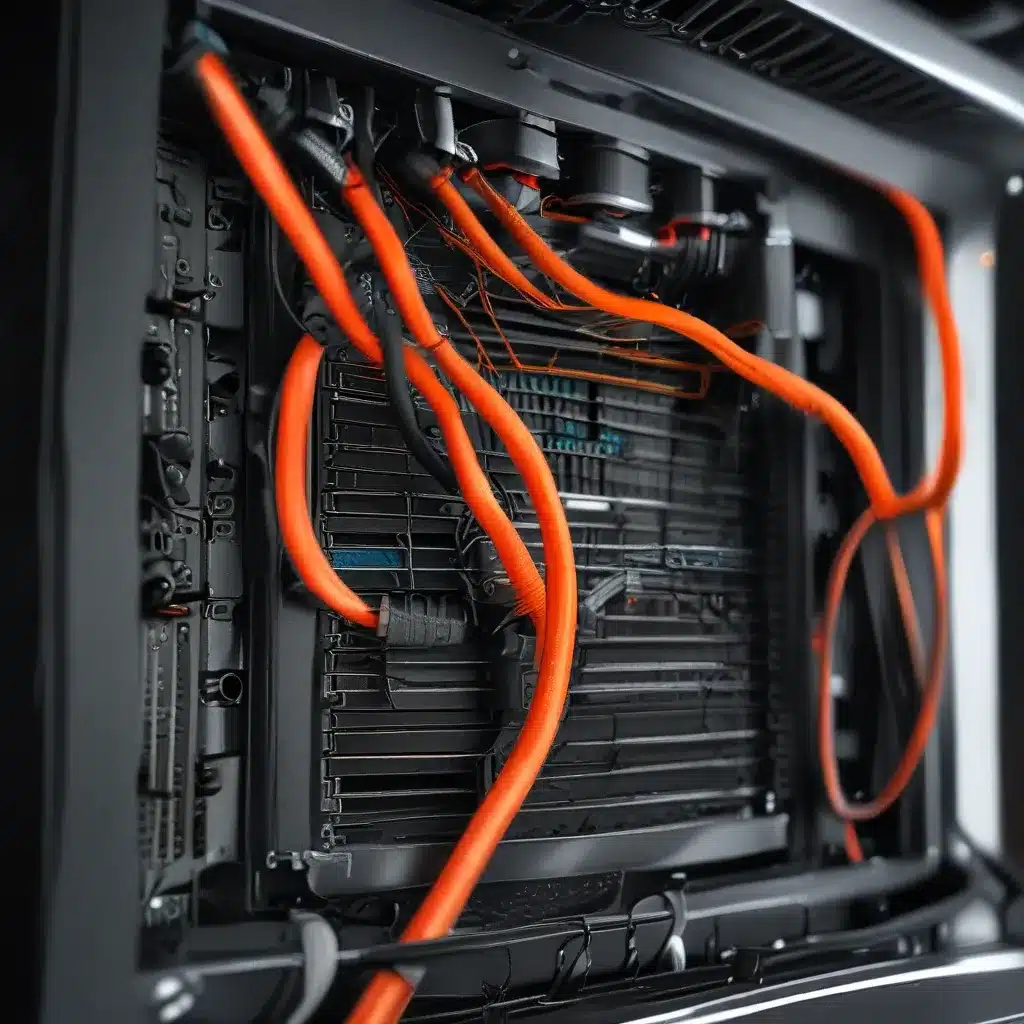
The Tangled Web We Weave
Picture this: you’re elbow-deep in the guts of a server, trying to troubleshoot a pesky issue. As you reach behind the rack, your hand gets snagged on a tangle of wires, and before you know it, you’ve accidentally pulled the wrong cable. Panic ensues as the server unceremoniously powers down, and you’re left with a mess of cords to sort through. Sound familiar? If you work in the world of computer repair, this scenario is probably all too common.
But fear not, my fellow IT techs! Today, I’m going to share some valuable insights on proper cable management that can help you avoid these frustrating situations and keep your clients’ systems running smoothly. Trust me, I’ve learned this the hard way over the years.
The Importance of Airflow
Now, you might be thinking, “Cable management? Who cares, as long as everything’s plugged in, right?” Wrong! Proper cable management is crucial for maintaining optimal airflow and cooling within a server or computer system. Think of it like this: imagine you’re trying to run a marathon, but someone has tied your shoelaces together. It’s going to be a whole lot harder to reach the finish line, isn’t it?
The same principle applies to the delicate components inside a computer. When cables are haphazardly strewn about, they can obstruct the airflow that’s essential for keeping those sensitive parts cool. And trust me, you don’t want to find out the hard way what happens when a CPU or graphics card overheats. It’s a recipe for disaster that no computer repair technician wants to deal with.
Taming the Tangles
So, how do you go about taming the cable tangles and ensuring that airflow is, well, flowing freely? It all comes down to a few key principles:
1. Measure Twice, Cut Once
Before you even start plugging in cables, take the time to carefully measure and plan out your cable routing. This will help you determine the optimal length for each cable, ensuring that you have just enough slack to comfortably reach the necessary ports without creating a rat’s nest of excess. Trust me, those few extra minutes spent planning will save you a world of frustration down the line.
2. Zip Ties Are the Enemy
I know, I know – zip ties seem like the perfect solution for bundling up those pesky cables. But hear me out: they’re actually more trouble than they’re worth. Those sharp little edges can easily snag on other components, and once you’ve cut one off, you’re left with a tiny, razor-sharp fragment that’s just waiting to draw blood. Ouch!
Instead, opt for the trusty old standby: Velcro. It’s reusable, it’s adjustable, and best of all, it won’t mutilate your fingers when you inevitably need to make a change. Plus, Velcro ties can be easily removed and reapplied, making it a breeze to access the cables you need to work on.
3. Organize, Organize, Organize
Remember that marathon analogy? Well, the key to keeping your cables from tripping you up is to organize them in a way that makes sense. Group cables by function, color-code them, and use cable trays or raceways to keep them neatly contained. This not only helps with airflow, but it also makes it a whole lot easier to troubleshoot any issues that may arise.
The Art of Cable Management
Now, I know what you’re thinking: “Okay, this all sounds great in theory, but how do I actually put it into practice?” Well, my friends, let me share a few of my favorite tips and tricks.
First and foremost, invest in some quality cable management accessories. Cable trays, sleeves, and organizers can make a world of difference in keeping your cables tidy and your airflow optimized. And don’t be afraid to get a little creative – I’ve seen some IT techs use everything from zip-up binders to PVC pipes to wrangle those pesky cords.
Secondly, keep a solid stash of Velcro ties on hand. Trust me, you’ll be reaching for them constantly as you work on different systems. And if you’re really feeling fancy, you can even get Velcro ties in a variety of colors to help color-code your cables.
Finally, consider using cable management arms – those nifty little attachments that allow you to slide servers in and out of racks without worrying about unplugging anything. They might not be the perfect solution for every situation, but they can be a godsend when you need to access the back of a densely packed server.
The Payoff
Now, I know what you’re thinking: “Alright, alright, I get it – cable management is important. But is it really worth all the time and effort?” The short answer? Absolutely.
Proper cable management can have a significant impact on your system’s performance and longevity. By keeping those cables neatly organized and allowing for optimal airflow, you’re helping to prevent overheating, reduce the risk of accidental disconnections, and make future maintenance and troubleshooting a breeze.
And let’s not forget about the aesthetic factor. A well-organized, tidy server or computer system just looks plain cool. Your clients will be impressed, and you’ll have the satisfaction of knowing that you’re providing the best possible service.
So, the next time you’re elbow-deep in a computer’s guts, remember the importance of proper cable management. With a little bit of planning and some Velcro-fueled creativity, you can keep those cables in check and ensure that your clients’ systems run smoothly for years to come.












